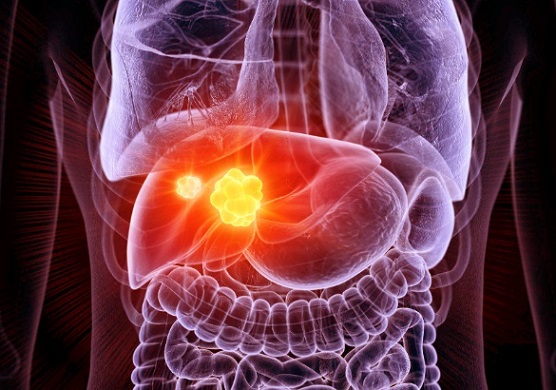Nikhil Prasad Fact checked by:Thailand Medical News Team Jan 13, 2025 10 months, 3 weeks, 6 days, 1 hour, 3 minutes ago
Medical News: Hepatocellular carcinoma (HCC) is among the deadliest cancers worldwide, ranking fifth in mortality. Despite advances in treatment options, such as surgery, radiotherapy, and drug therapy, the prognosis remains grim for many patients. Traditional treatment methods often fall short due to poor efficacy, high recurrence rates, and limited applicability to certain patient groups. In this context, researchers from the Innovation Center of Molecular Diagnostics at Beijing University of Chemical Technology in China have been exploring novel approaches to target HCC. Their study on rhoifolin (ROF), a naturally occurring flavonoid, offers a promising avenue for treatment.
 Rhoifolin as a Potential Game-Changer in Liver Cancer Treatment
Rhoifolin as a Potential Game-Changer in Liver Cancer Treatment
Rhoifolin is a chemical compound first isolated from the plant Rhus succedanea. The name "Rhoi" is derived from the generic name of the plant Rhus. It belongs to the flavone class of flavonoids and has been identified in several plant sources, including the leaves of Boehmeria nivea (China grass or ramie), Citrus limon (Canton lemon), Citrus x aurantium (bitter orange), and Citrus x paradisi (grapefruit). It has also been found in the shoots of Ononis campestris (cammock) and the fruit of Sabal serratula (serenoa or sabal).
This
Medical News report delves into the details of this study, highlighting the significant findings and their potential impact on cancer therapeutics. Rhoifolin, previously recognized for its anti-inflammatory and antioxidant properties, has now been investigated for its ability to suppress HCC growth and induce apoptosis in cancer cells.
Methods and Key Experimental Approaches
To evaluate the effects of rhoifolin, the research team conducted a series of experiments using HepG2 and HuH7 liver cancer cell lines. They employed methods such as the CCK8 assay to assess cell proliferation, flow cytometry for apoptosis and cell cycle analysis, and quantitative real-time PCR and Western blotting to uncover the underlying mechanisms of rhoifolin’s action. Additionally, they tested its efficacy in vivo using a mouse model implanted with HCC cells.
The team’s meticulous methodology ensured a comprehensive understanding of rhoifolin’s impact on cancer cells. They measured the IC50 values - a crucial indicator of drug potency - and analyzed changes in gene and protein expression related to apoptosis and cell cycle regulation.
Key Findings: A Breakthrough in Cancer Research
One of the most striking outcomes was rhoifolin’s ability to inhibit cell proliferation in a dose-dependent and time-dependent manner. The IC50 values of rhoifolin for HepG2 cells were 373.9 µg/mL at 24 hours and 208.9 µg/mL at 48 hours, while for HuH7 cells, the values were 288.7 µg/mL and 218.0 µg/mL, respectively. These results underline rhoifolin’s potency in halting the growth of liver cancer cells.
Moreover, the study revealed a significant increase in apoptosis - a programmed cell death process c
rucial for eliminating cancer cells. After 48 hours of treatment, the apoptosis rate in HepG2 cells surged from 6.63% to 30.04%, while in HuH7 cells, it rose from 6.59% to 37.90%. This marked a dramatic shift in the cells’ fate, pointing to rhoifolin’s strong pro-apoptotic properties.
Rhoifolin also induced cell cycle arrest at the S phase, preventing cells from dividing and proliferating further. The proportion of cells in the S phase increased from 39.71% to 51.84% in HepG2 cells and from 30.31% to 41.51% in HuH7 cells, depending on the concentration of rhoifolin. This disruption in the cell cycle underscores rhoifolin’s potential to suppress cancer progression effectively.
Mechanisms Behind Rhoifolin’s Efficacy
The researchers delved deeper to identify the molecular pathways influenced by rhoifolin. They observed a significant upregulation in the expression of pro-apoptotic proteins such as PIDD1, BID, BAX, BAK1, and BIM. Caspase proteins, particularly CASP8 and CASP9, which are pivotal in apoptosis signaling, also showed increased expression. These proteins collectively facilitate the breakdown of cancer cells by disrupting mitochondrial integrity and activating apoptotic pathways.
In addition to these molecular findings, rhoifolin’s impact was confirmed in a mouse model of HCC. Tumor growth in rhoifolin-treated mice was markedly suppressed compared to the control group. The average tumor volume in the treated group was significantly smaller, indicating the compound’s efficacy in vivo. Importantly, no toxicity was observed in the mice’s vital organs, reinforcing rhoifolin’s safety profile.
Why Rhoifolin Matters in Cancer Research
The ability to selectively target cancer cells while sparing healthy tissue is a hallmark of an ideal anticancer agent. Rhoifolin’s selective toxicity and minimal side effects make it a promising candidate for further development. Its ability to interfere with critical cellular processes such as proliferation and apoptosis positions it as a potential game-changer in liver cancer therapy.
Moreover, the study’s findings contribute to a broader understanding of how natural compounds can be leveraged to combat cancer. Traditional Chinese medicine has long utilized flavonoids for their health benefits, and this research underscores their relevance in modern oncology.
Conclusions: A New Hope for Liver Cancer Patients
The study highlights rhoifolin’s remarkable potential in treating hepatocellular carcinoma. By effectively inhibiting cancer cell growth, inducing apoptosis, and causing cell cycle arrest, rhoifolin demonstrates a multi-faceted approach to combating liver cancer. Its high potency, as reflected in its low IC50 values, suggests that therapeutic effects can be achieved at relatively low doses, minimizing the risk of adverse side effects.
Furthermore, the in vivo experiments underscore rhoifolin’s safety and efficacy, showing that it can suppress tumor growth without harming healthy tissues. This selective action not only enhances its therapeutic appeal but also sets the stage for further exploration in clinical settings.
As researchers continue to uncover the mechanisms underlying rhoifolin’s effects, its potential for integration into combination therapies and its application to other types of cancer appear promising.
The study findings were published in the peer-reviewed journal: Pharmaceuticals.
https://www.mdpi.com/1424-8247/18/1/79
For the latest on Liver Cancer, keep on logging to Thailand
Medical News.
Read Also:
https://www.thailandmedical.news/news/breaking-study-finds-that-covid-19-accelerates-liver-cancer-growth-and-spread-via-exosomes-derived-from-syncytia
https://www.thailandmedical.news/news/sars-cov-2-spike-protein-interacts-with-12-liver-proteins-reactivates-hbv-and-activates-pre-cancerous-pathways
https://www.thailandmedical.news/news/advanced-treatment-options-for-liver-cancer
https://www.thailandmedical.news/news/study-shows-iberverin-from-cabbage-as-a-potent-ally-against-liver-cancer-cells-by-inducing-ferroptosis
https://www.thailandmedical.news/news/covid-19-worsens-existing-liver-disease-and-could-spur-liver-cancer-development
